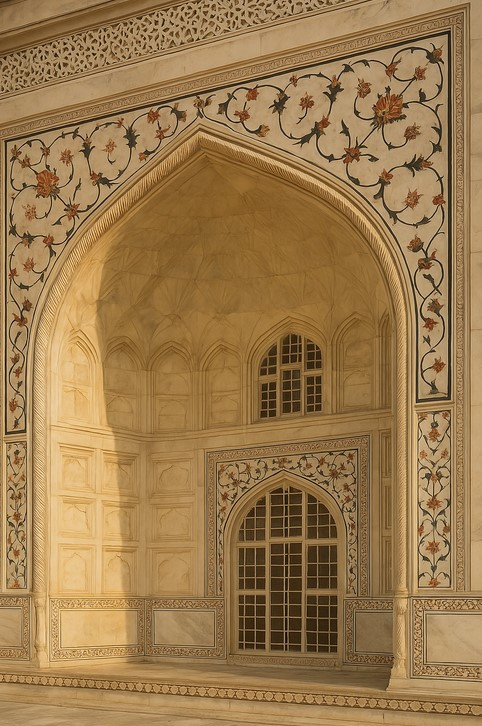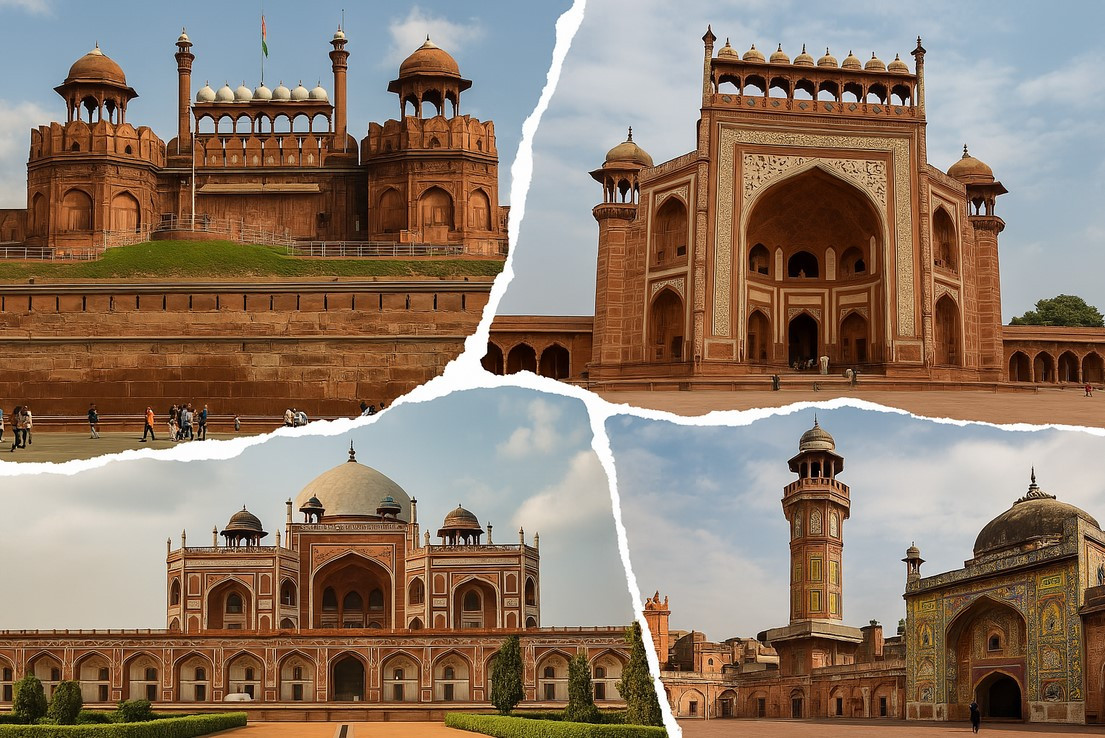Mughal architecture represents a unique symbiosis of Persian, Indian, and Islamic traditions. It flourished during the era of the Great Mughal dynasty from the 16th to the 18th century. These magnificent masterpieces of Great Mughal architecture, built from red sandstone and white marble, still take your breath away with their monumentality, perfect symmetry, and exquisite decor.
What is Mughal architecture and its main features
Mughal architecture is distinguished by a harmonious combination of majestic monumentality and delicate decorativeness. The Indo-Islamic style, formed during this period, created a distinctive visual language, instantly recognizable worldwide. This architectural heritage of India is connected to the cultural influence of the Timurid dynasty, from which the Great Mughals descended.
"Mughal architects created a unique visual language, where domes and arches are not merely structural elements, but symbols of the connection between the earthly and the heavenly. Symmetry in their works – is the embodiment of the idea of perfection and divine order." — Ebba Koch, architectural historian
 Key elements that define the distinctive appearance of Mughal architecture:
Key elements that define the distinctive appearance of Mughal architecture:
- Majestic onion-shaped domes reaching toward the sky
- Pointed arches and elegant minarets, creating a sense of lightness
- Strict symmetry in architecture, symbolizing perfection
- Abundance of decorative details and marble inlay that captivate the imagination
- Contrast of natural materials — red sandstone and snow-white marble
- Integration of buildings with Char Bagh gardens — earthly reflections of paradise gardens
- Refined calligraphy in architecture, adorning facades and interiors
For finishing, Great Mughal architects used bright colored tiles, shimmering marble inlay with precious and semi-precious stones (the pietra dura technique), as well as the finest stone carving. In the interiors of Mughal mosques and mausoleums, wall and ceiling paintings with plant-like ornaments are often found. These patterns seem to come alive with the play of light, creating an effect of movement. Many of these unique monuments of Mughal architecture are now under UNESCO protection and included in the World Heritage List or in preliminary lists, such as the Mughal mosques in Bangladesh.
Iconic monuments of Mughal architecture
 The most significant examples of Mughal architecture and Islamic art in India are located in the cities of Northern India — Delhi, Agra, Lahore, and Fatehpur Sikri. Each of them illustrates different stages in the development of this unique Indo-Islamic style. When you first see these structures in person, you experience an indescribable feeling of admiration – their scale and refinement of details literally make you freeze in amazement.
The most significant examples of Mughal architecture and Islamic art in India are located in the cities of Northern India — Delhi, Agra, Lahore, and Fatehpur Sikri. Each of them illustrates different stages in the development of this unique Indo-Islamic style. When you first see these structures in person, you experience an indescribable feeling of admiration – their scale and refinement of details literally make you freeze in amazement.
| Monument | Location | Construction period | Ruler | Features |
|---|---|---|---|---|
| Taj Mahal | Agra | 1632-1653 | Shah Jahan | Mausoleum of white marble, a masterpiece of symmetry and inlay |
| Red Fort | Delhi | 1638-1648 | Shah Jahan | Majestic complex of red sandstone with marble pavilions |
| Humayun's Tomb | Delhi | 1565-1572 | Akbar | Prototype for the Taj Mahal, a combination of Persian and Indian elements |
| Fatehpur Sikri | Near Agra | 1571-1585 | Akbar | Palace-city of red sandstone, combination of Hindu and Islamic motifs |
| Pearl Mosque | Agra | 1648-1655 | Shah Jahan | Snow-white marble mosque inside the fort |
This table demonstrates the diversity of Mughal architectural heritage, from massive forts and palaces to elegant mausoleums and Mughal mosques, created by great emperors. Besides these famous monuments, there are less known but equally interesting examples of Mughal architecture. Among them — the tomb of Itimad-ud-Daulah in Agra, often called the "Baby Taj," the Jahangiri Mahal palace in Agra Fort, and the Wazir Khan Mosque in Lahore with its stunning tiles. These structures reveal additional facets of this amazing architectural style of the Great Mughals.
Taj Mahal — the pearl of Mughal architecture
 The famous mausoleum in Agra is considered the absolute masterpiece of Mughal architecture and one of the wonders of the world. Built by Emperor Shah Jahan in memory of his beloved wife Mumtaz Mahal, this monument embodies the highest mastery of Indo-Islamic style architects.
The famous mausoleum in Agra is considered the absolute masterpiece of Mughal architecture and one of the wonders of the world. Built by Emperor Shah Jahan in memory of his beloved wife Mumtaz Mahal, this monument embodies the highest mastery of Indo-Islamic style architects.
"In the Taj Mahal, architecture and garden art merged together, creating perfect harmony. The white marble, changing shades depending on the time of day, seems alive. This is not just a building — it is a poem in stone, reflecting the depth of human feelings." — Rabindranath Tagore, Indian poet
The mausoleum is built entirely of white marble with stunning marble inlay of semi-precious stones. The main dome, minarets, and characteristic architectural forms create an ideally symmetrical composition. The pearl of Mughal architecture is surrounded by a Char Bagh garden, divided into four parts with water channels — a typical element for the Indo-Islamic style.
Success story: Restoration of India's architectural heritage
 In the early 2000s, the Red Fort in Delhi, an outstanding example of Mughal architecture made of red sandstone, was in a deplorable condition. The preservation of Mughal architecture was at risk. Many decorative elements were damaged, and some pavilions required urgent restoration. In 2003, an ambitious project was launched to restore this architectural complex.
In the early 2000s, the Red Fort in Delhi, an outstanding example of Mughal architecture made of red sandstone, was in a deplorable condition. The preservation of Mughal architecture was at risk. Many decorative elements were damaged, and some pavilions required urgent restoration. In 2003, an ambitious project was launched to restore this architectural complex.
A team of 200 restorers and masters of traditional crafts worked on recreating the original Mughal construction techniques. They used traditional materials — the same red sandstone from historical quarries — and recreated marble inlay according to ancient schemes. Thanks to traditional methods and modern conservation technologies, it was possible not only to improve the preservation of Mughal architecture but also to restore the former grandeur of this Indo-Islamic style monument.
Today, the restored Red Fort annually attracts millions of Mughal architecture photography enthusiasts and serves as a vivid example of how the architectural heritage of the Great Mughals can be preserved for future generations.
Influence of Persian art on the Mughal style
The architecture of the Great Mughals was formed under the significant influence of Persian art and architectural traditions that the Mughals brought to India. Persian architecture enriched the Mughal style with elements such as iwans (massive portals), pishtaqs (monumental entrance arches), and characteristic onion-shaped domes.
At the same time, the architects of the Timurid dynasty did not simply copy Persian examples but creatively reworked them, synthesizing them with local Indian traditions. As a result of this symbiosis, a unique Indo-Islamic style emerged, which became the hallmark of Mughal architecture and an important part of India's architectural heritage.
The significance of the Mughal style in world architecture
Mughal architecture had an enormous influence on the development of architecture not only in India but also in other Asian countries. Its traditions formed the basis of the Indo-Saracenic style, which became widespread in the colonial period. Even today, centuries after the fall of the Great Mughal Empire, these architectural masterpieces continue to inspire and amaze, evoking awe and admiration in everyone who is fortunate enough to see them.
"The achievements of Mughal architecture in creating grand spaces, the play of light and shadow, the integration of the building with its natural surroundings anticipated many principles of modern architecture. From the Taj Mahal to modern public buildings — the thread of this influence can be traced through the centuries." — Charles Correa, contemporary Indian architect
The combination of refinement and monumentality, characteristic of Mughal architecture, continues to inspire modern architects. Elements of the Mughal style can be seen in many modern buildings in India, Pakistan, and other countries, where architects turn to the rich heritage of the Indo-Islamic style, which was formed on the subcontinent as a result of the synthesis of local and imported Islamic architectural traditions.
For those interested in Islamic art in India and wanting to see these monuments with their own eyes, various tours to India with visits to the main sites of Mughal architecture are available today. Excursions to the Taj Mahal and other Mughal monuments allow you not only to enjoy their beauty but also to purchase unique Taj Mahal souvenirs, reminding of the grandeur of this architectural style.

